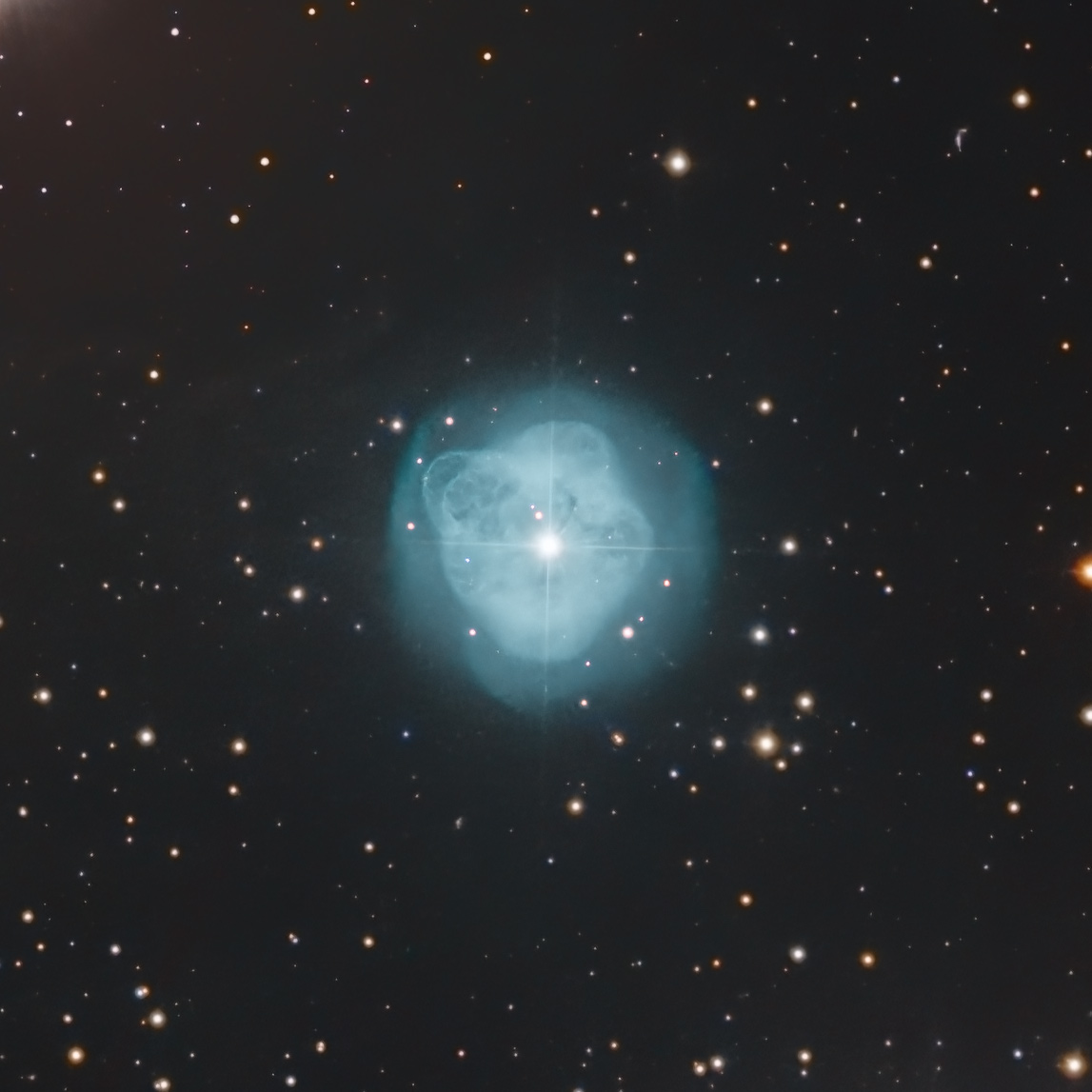NGC 1514, also known as the Crystal Ball Nebula (presumably because of some idea, when seen through early telescopes, that it looked like a
crystal ball), is a planetary nebula, the type of nebula which it is generally thought our Sun will produce as nuclear fusion slows and then dies in its core, and it expels
its outer layers of gas. It is perhaps about 1500 light years from Earth (estimates vary widely). NGC 1514 is only about 2 arcminutes across (including the fainter outer
shell), which translates to about one light year in diameter (visible part).
This gorgeous little nebula has an intereting origin story, and an interesting discovery story.
The nebula was produced when one of the two stars in a binary star reached the end of its "normal" life, and puffed out its outer layer. The bright star at the center of the
nebula is the surviving star of the pair, a giant star; the progenitor star no longer is visible, having long ago collapsed into a white dwarf.
The "interesting discovery story" is simply that William Herchel, who is credited with having discovered the nebula, was able to see it with enough detail to guess that (unlike
prevailing astronomical theory at the time) the nebulosity wasn't a whole bunch of faint stars, but "not of a starry nature."
I have included uncropped versions, because I always like seeing the tiny (meaning very distant) background galaxies. In particular, note the nice barred sprial galaxy near the
middle of the left edge, PGC 1905882, a magnitude 16 gem.
Technical Information:
Ha:OIII:L:R:G:B: 570:600:555:240:180:240 (a total of almost 40 hours of light-frame exposure time); luminance layer was a combination of thirty-seven
15-minute images through a luminance filter; red was a blend of sixteen 15-minute images though a red-pass filter, and nineteen 30-minute images through an Ha filter;
green was a blend of twelve 15-minute images through a green-pass filter and twenty 30-minute images through an OIII filter; blue was a blend of twelve 20-minute images
through a blue pass filter and the OIII data also used in the green channel. Doubly-ionized oxygen emits light at the intersection of the blue and the green part of the
visible light spectrum, so we add that data equally to both the blue and green.
Equipment: RC Optical Systems 14.5 inch Ritchey-Chretien carbon fiber truss telescope, with ion-milled optics and RCOS field flattener, at about f/9, and an SBIG STX-16803 camera with
internal filter wheel (SBIG filter set), guided by an SBIG AO-X, all riding on a Bisque Paramount ME German Equatorial Mount.
Image Acquisition/Camera Control: Maxim DL, controlled with ACP Expert/Scheduler, working in concert with TheSkyX.
Processing: All images calibrated (darks, bias and sky flats), aligned, combined and cropped in Pixinsight. Color combine in Pixinsight. Some finish work (background neutralization,
color calibration, some sharpening, deconvolution with BlurXterminator, and noise reduction with NoiseXterminator) done in Pixinsight; some cleanup finish work was done in Photoshop CC.
Location: Data acquired remotely from Sierra Remote Observatories, Auberry, California, USA.
Date: Images taken on many nights in November and December of 2022. Image posted July 2, 2023.
Date: Image scale of full-resolution image: 0.56 arcseconds per pixel.
Seeing: Generally good
CCD Chip temperature: -25C
Copyright 2022, 2023
Mark de Regt

